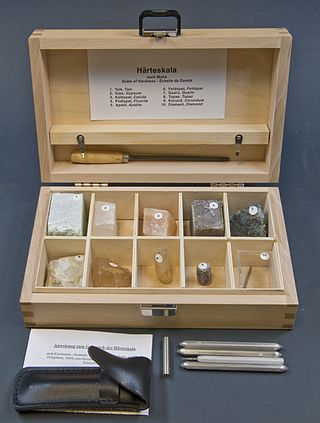
The Mohs scale of mineral hardness is a qualitative ordinal scale, from 1 to 10, characterizing scratch resistance of minerals through the ability of harder material to scratch softer material.

Sillimanite or fibrolite is an aluminosilicate mineral with the chemical formula Al2SiO5. Sillimanite is named after the American chemist Benjamin Silliman (1779–1864). It was first described in 1824 for an occurrence in Chester, Connecticut.

Rhodochrosite is a manganese carbonate mineral with chemical composition MnCO3. In its pure form (rare), it is typically a rose-red colour, but it can also be shades of pink to pale brown. It streaks white, and its Mohs hardness varies between 3.5 and 4.5. Its specific gravity is between 3.45 and 3.6. The crystal system of rhodochrosite is trigonal, with a lattice structure and cleavage in the carbonate rhombohedral system. The carbonate ions (CO2−
3) are arranged in a triangular planar configuration, and the manganese ions (Mn2–) are surrounded by six oxygen ions in an octahedral arrangement. The MnO6 octahedra and CO3 triangles are linked together to form a three-dimensional structure. Crystal twinning is often present. It can be confused with the manganese silicate rhodonite, but is distinctly softer. Rhodochrosite is formed by the oxidation of manganese ore, and is found in South Africa, China, and the Americas. It is one of the national symbols of Argentina.

Colemanite (Ca2B6O11·5H2O) or (CaB3O4(OH)3·H2O) is a borate mineral found in evaporite deposits of alkaline lacustrine environments. Colemanite is a secondary mineral that forms by alteration of borax and ulexite.

Diopside is a monoclinic pyroxene mineral with composition MgCaSi
2O
6. It forms complete solid solution series with hedenbergite and augite, and partial solid solutions with orthopyroxene and pigeonite. It forms variably colored, but typically dull green crystals in the monoclinic prismatic class. It has two distinct prismatic cleavages at 87 and 93° typical of the pyroxene series. It has a Mohs hardness of six, a Vickers hardness of 7.7 GPa at a load of 0.98 N, and a specific gravity of 3.25 to 3.55. It is transparent to translucent with indices of refraction of nα=1.663–1.699, nβ=1.671–1.705, and nγ=1.693–1.728. The optic angle is 58° to 63°.
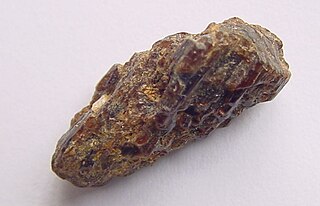
Painite is a very rare borate mineral. It was first found in Myanmar by British mineralogist and gem dealer Arthur C.D. Pain who misidentified it as ruby, until it was discovered as a new gemstone in the 1950s. When it was confirmed as a new mineral species, the mineral was named after him. Due to its rarity, painite can cost between US$50,000 to $60,000 per carat.
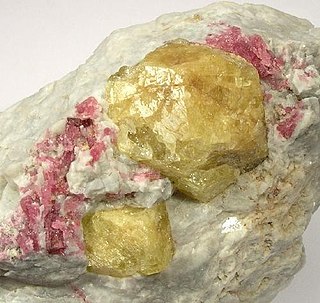
The Borate Minerals are minerals which contain a borate anion group. The borate (BO3) units may be polymerised similar to the SiO4 unit of the silicate mineral class. This results in B2O5, B3O6, B2O4 anions as well as more complex structures which include hydroxide or halogen anions. The [B(O,OH)4]− anion exists as well.
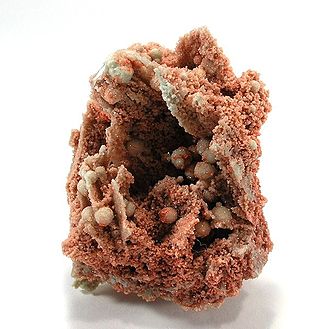
Hilgardite is a borate mineral with the chemical formula Ca2B5O9Cl·H2O. It is transparent and has vitreous luster. It is colorless to light pink with a white streak. It is rated 5 on the Mohs Scale. It crystallizes in the triclinic crystal system. Crystals occur as distorted tabular triangles and are hemimorphic, polytypes exist.
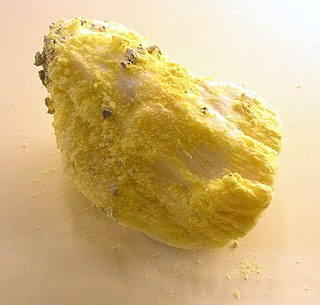
Sassolite is a borate mineral, specifically the mineral form of boric acid. It is usually white to gray, and colourless in transmitted light. It can also take on a yellow colour from sulfur impurities, or brown from iron oxides.

Howlite, a calcium borosilicate hydroxide (Ca2B5SiO9(OH)5), is a borate mineral found in evaporite deposits.

Nickel–Strunz classification is a scheme for categorizing minerals based upon their chemical composition, introduced by German mineralogist Karl Hugo Strunz in his Mineralogische Tabellen (1941). The 4th and the 5th edition was also edited by Christel Tennyson (1966). It was followed by A.S. Povarennykh with a modified classification.

Jeremejevite is an aluminium borate mineral with variable fluoride and hydroxide ions. Its chemical formula is Al6B5O15(F,OH)3. It is considered as one of the rarest, thus one of the most expensive stones. For nearly a century, it was considered as one of the rarest gemstones in the world.

Avogadrite ((K,Cs)BF4) is a potassium-caesium tetrafluoroborate in the halide class. Avogadrite crystallizes in the orthorhombic system (space group Pnma) with cell parameters a 8.66 Å, b 5.48 Å and c Å 7.03.
Henry How was a British-Canadian chemist, geologist and mineralogist.
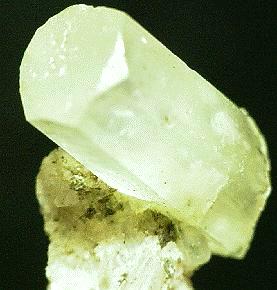
Milarite is a rare beryl. It is a member of the osumilite group. Crystals of this mineral typically come in green or yellow. The mineral gets name after Val Milar.
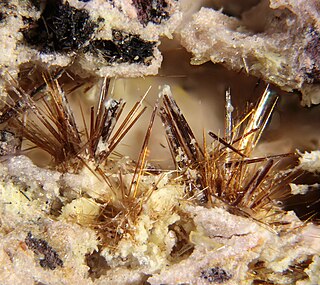
Yuanfuliite is a black submetal mineral. The mineral is named after the geologist Yuan Fuli.

Aquamarine is a pale-blue to light-green variety of beryl. The color of aquamarine can be changed by heat.

Johannsenite is a silicate mineral that is a member of the pyroxene family. The mineral can be produced in limestone or due a metamorphic process. The mineral is also associated with Pb-Zn mineralization.
Tsilaisite is a manganese rich variety of elbaite tourmaline. It is also known as Tsilaizite. Tsilaisite is related Fluor-tsilaisite. The gem is named after the location it was first found.

Lizardite is a mineral from the serpentine subgroup with formula Mg3(Si2O5)(OH)4, and the most common type of mineral in the subgroup. It is also a member of the kaolinite-serpentine group.


















